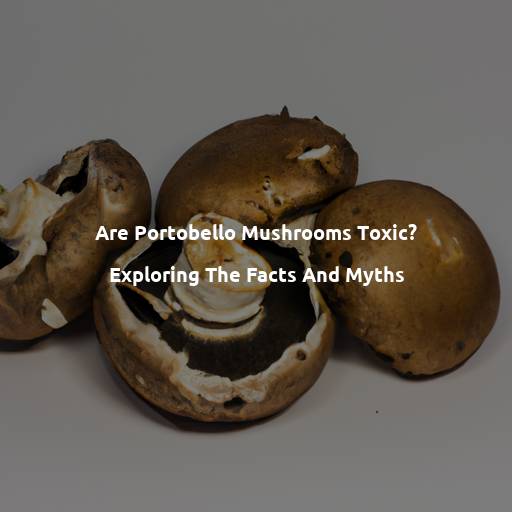Introduction to Portobello Mushrooms
Portobello mushrooms, also known as Agaricus bisporus, are a popular and versatile ingredient in many cuisines. These mushrooms are commonly grown and consumed for their unique flavor and meaty texture. With their large, round caps and rich brown color, Portobello mushrooms are not only visually appealing but also offer a range of health benefits.
When cooked, Portobello mushrooms can develop a savory umami flavor that adds depth to numerous dishes. They can be grilled, roasted, stuffed, or used as a meat substitute in vegetarian or vegan recipes. However, before diving into the various ways to enjoy Portobello mushrooms, it’s important to understand their potential toxicity and debunk any myths surrounding their safety.
In this article, we will explore the facts and myths about the toxicity of Portobello mushrooms. By addressing these topics, we aim to provide you with the necessary information to make informed decisions when it comes to consuming this popular fungus. So, let’s dive into the world of Portobello mushrooms and unravel the truth about their potential toxicity.
Understanding Potential Toxicity of Portobello Mushrooms
Portobello mushrooms, known for their meaty texture and earthy flavor, are a popular choice among mushroom enthusiasts. However, there have been concerns and discussions regarding their potential toxicity. In this section, we will explore the facts and shed light on the topic of Portobello mushroom toxicity.
Despite their appealing characteristics, it’s important to understand that Portobello mushrooms belong to the same species as white button mushrooms, scientifically known as Agaricus bisporus. While they are generally safe for consumption, there are factors that may contribute to their potential toxicity.
One significant factor is the mushroom’s maturity. As Portobello mushrooms mature and their gills begin to darken, they produce more spores. Some people may experience gastric discomfort or digestive issues when consuming mature Portobello mushrooms due to the higher spore content. It is advisable to consume them when they are still in their young, button stage for better digestion.
Another consideration is individual sensitivities. Like any food, some individuals may be more susceptible to adverse reactions or allergies to Portobello mushrooms. If you have a known sensitivity to mushrooms or other fungi, it is best to exercise caution or seek medical advice before consuming them.
Cooking Portobello mushrooms thoroughly also plays a crucial role in minimizing potential toxicity. Heat treatment not only enhances their flavor but also breaks down certain compounds that may cause digestive discomfort. Additionally, cooking eliminates any potential bacteria or fungi that could pose a health risk.
In summary, while Portobello mushrooms are generally safe for consumption, it’s important to be aware of the potential factors that may contribute to their toxicity. Practicing proper mushroom selection, ensuring they are consumed at the appropriate maturity stage, and cooking them thoroughly can help mitigate any potential risks associated with Portobello mushroom consumption.
Are There Any Known Cases of Portobello Mushroom Toxicity?
Portobello mushrooms are a popular choice for many dishes due to their meaty texture and rich flavor. However, concerns about the potential toxicity of these mushrooms have raised questions in the minds of some consumers. While there have been reports of mushroom poisonings, it is important to note that cases of portobello mushroom toxicity are extremely rare.
One known case of portobello mushroom toxicity occurred in 2006 when a family consumed raw mushrooms that they had mistaken for the edible variety. The family experienced symptoms such as nausea, vomiting, and diarrhea. It was later revealed that the mushrooms were not actually portobellos but a different species known to be toxic.
In general, portobello mushrooms are considered safe to eat when properly cooked. As with any food, it is essential to handle and prepare them correctly to minimize the risk of illness. Always ensure that mushrooms are sourced from reputable suppliers and inspect them for any signs of spoilage or contamination before consumption.
It is worth noting that individual reactions to portobello mushrooms may vary. Some people may be more sensitive and experience gastrointestinal discomfort after consuming these mushrooms. If you have any concerns or experience adverse reactions, it is advisable to consult a healthcare professional.
In conclusion, while there have been isolated incidents of mushroom poisoning related to misidentification or consumption of toxic mushrooms, cases of portobello mushroom toxicity are rare. By following proper handling and cooking guidelines, you can continue to enjoy the delicious flavor of portobello mushrooms in your favorite dishes safely.
Common Myths Surrounding Portobello Mushroom Toxicity
1. Myth: Portobello mushrooms are automatically toxic if they turn dark.
Fact: It is a common misconception that portobello mushrooms become toxic when they darken. The darkening of portobello mushrooms is a natural aging process and does not indicate toxicity. In fact, the darker the mushroom cap, the more intense the flavor and texture may be, making them a popular choice for cooking.
2. Myth: Portobello mushrooms should be avoided because they are a type of poisonous mushroom.
Fact: Portobello mushrooms are not poisonous. They are actually a fully mature form of the common white button mushroom (Agaricus bisporus). These mushrooms are widely consumed and enjoyed around the world without any reported cases of toxicity.
3. Myth: Eating raw portobello mushrooms can lead to serious health issues.
Fact: While it is generally recommended to cook mushrooms before consuming them, including portobellos, eating raw portobello mushrooms is not inherently dangerous or toxic. However, some individuals may experience digestive discomfort from consuming raw mushrooms, so it is advisable to cook them thoroughly to enhance both the taste and digestibility.
4. Myth: Portobello mushrooms absorb toxins from the environment, making them unsafe for consumption.
Fact: Portobello mushrooms, like other mushrooms, may absorb toxins and pollutants from their surroundings to some extent. However, studies have shown that they have a natural ability to convert and neutralize potentially harmful substances. Additionally, commercially grown portobello mushrooms undergo careful cultivation practices to minimize exposure to contaminants, ensuring their safety for consumption.
5. Myth: Cooking portobello mushrooms reduces their nutritional value.
Fact: The truth is quite the opposite. Cooking portobello mushrooms actually enhances their nutritional value by making the nutrients more bioavailable and easier for the body to absorb. Heat breaks down the tough cell walls of the mushrooms, releasing essential vitamins, minerals, and antioxidants. So, don’t be afraid to cook your portobellos, as they can offer both great taste and nutritional benefits.
6. Myth: Portobello mushrooms have hallucinogenic properties, similar to magic mushrooms.
Fact: Portobellos are not hallucinogenic mushrooms. They belong to the harmless and widely consumed cultivated mushroom varieties that are commonly used in cooking. Unlike certain species of magic mushrooms, portobellos and other culinary mushrooms do not contain psychoactive compounds such as psilocybin.
By debunking these common myths, it becomes clear that portobello mushrooms are safe, delicious, and nutritious additions to your meals. Enjoy their rich flavors and various culinary possibilities without worrying about any inherent toxicity.
Factors That May Determine the Toxicity of Portobello Mushrooms
The toxicity of Portobello mushrooms can vary depending on certain factors. Understanding these factors can help you make informed decisions when consuming Portobello mushrooms. Here are some important factors that may determine the toxicity of Portobello mushrooms:
1. Growing Conditions: The growing conditions, such as the quality of soil, temperature, and humidity, can impact the toxicity of Portobello mushrooms. Mushrooms that are grown in contaminated or unsanitary conditions may contain toxins that can be harmful when ingested.
2. Maturity and Harvesting: The maturity of Portobello mushrooms can play a role in their toxicity. As mushrooms mature, they may accumulate toxins or become more susceptible to contamination. Additionally, improper harvesting techniques or harvesting mushrooms past their prime can lead to increased toxic compounds.
3. Storage and Handling: How Portobello mushrooms are stored and handled can affect their toxicity. Exposure to excessive heat, moisture, or unhygienic handling practices can promote the growth of harmful organisms or toxins. It’s essential to store and handle Portobello mushrooms properly to minimize the risk of toxicity.
4. Interactions with Other Substances: Portobello mushrooms may interact with certain substances, such as medications or alcohol, potentially leading to adverse effects. It’s crucial to be aware of any potential interactions and avoid consuming Portobello mushrooms if contraindicated.
5. Individual Sensitivity: Each person’s sensitivity to toxins or allergens present in Portobello mushrooms can vary. Some individuals may be more susceptible to the toxic effects, while others may be more tolerant. Being aware of your own sensitivities can help you determine whether Portobello mushrooms are suitable for your consumption.
Remember, while Portobello mushrooms are generally safe for consumption, it’s always important to source them from reputable suppliers and ensure proper cooking techniques to minimize any potential toxicity.
Guidelines for Safely Consuming Portobello Mushrooms
When it comes to safely consuming portobello mushrooms, following certain guidelines can help ensure that you enjoy their delicious flavors without any potential risks. Here are some tips to consider:
1. Choose fresh and high-quality mushrooms: Opt for portobello mushrooms that are firm, plump, and free from bruises or signs of decay. Fresh mushrooms are less likely to harbor harmful microorganisms or develop toxins.
2. Properly store mushrooms: Keep your portobello mushrooms in a cool and dry place, preferably in a paper bag or a breathable container. Avoid storing them in airtight plastic bags, as they can become damp and promote bacterial growth.
3. Thoroughly clean mushrooms before cooking: Rinse the portobello mushrooms under cold running water to remove any dirt or debris. Gently pat them dry with a clean kitchen towel or paper towel.
4. Cook mushrooms thoroughly: Always ensure that portobello mushrooms are cooked thoroughly before consumption. Cooking at high temperatures helps destroy any potential bacteria or harmful substances that might be present.
5. Avoid consuming raw or undercooked mushrooms: While some mushrooms can be enjoyed raw or lightly cooked, it is generally recommended to cook portobello mushrooms thoroughly. This helps break down certain compounds that may be difficult to digest and eliminates the risk of potential toxicity.
6. Practice proper food handling and hygiene: Wash your hands thoroughly before and after handling mushrooms or any other food items. Use separate cutting boards and utensils for mushrooms to prevent cross-contamination with other ingredients.
7. Consume mushrooms from reliable sources: When purchasing portobello mushrooms, buy them from reputable suppliers or grocery stores known for their quality produce. This reduces the likelihood of consuming mushrooms that may have been exposed to contaminants.
8. Store leftovers properly: If you have any leftover cooked portobello mushrooms, refrigerate them promptly in a sealed container. Consume within a few days to maintain their freshness and minimize any potential risks.
By following these guidelines for safely consuming portobello mushrooms, you can confidently enjoy their rich flavors and nutritional benefits. Remember, proper handling, cooking, and sourcing play crucial roles in ensuring a safe and delightful culinary experience.
Conclusion and Final Thoughts on Portobello Mushroom Toxicity
In conclusion, it is essential to debunk the myths surrounding the toxicity of Portobello mushrooms. While there have been isolated incidents of mushroom poisonings due to misidentification or consumption of toxic mushrooms, cases of Portobello mushroom toxicity are extremely rare. Portobello mushrooms are generally safe for consumption when handled, cooked, and sourced properly.
Factors such as maturity, individual sensitivities, and cooking techniques play a role in minimizing potential toxicity. It is advisable to consume Portobello mushrooms when they are still in their young, button stage for better digestion. Cooking Portobello mushrooms thoroughly not only enhances their flavor but also breaks down certain compounds that may cause digestive discomfort. Additionally, commercially grown Portobello mushrooms undergo careful cultivation practices to ensure their safety.
By following guidelines such as choosing fresh mushrooms, proper storage, thorough cleaning, and safe handling practices, you can enjoy Portobello mushrooms without any potential risks. Remember to source them from reputable suppliers and cook them thoroughly before consumption.
In a nutshell, Portobello mushrooms are safe, delicious, and offer numerous culinary possibilities. Enjoy their meaty texture, rich flavor, and nutritional benefits while incorporating them into your favorite recipes. Happy cooking and bon appétit!

